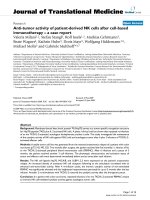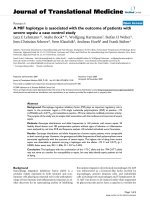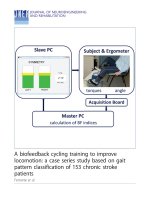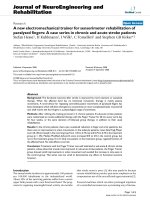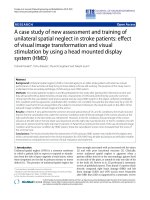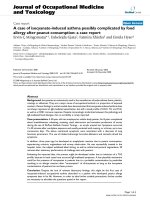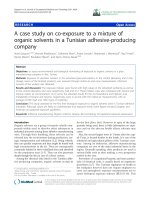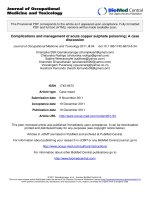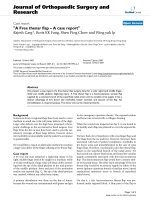báo cáo hóa học:" A case report of a septic hip secondary to a psoas abscess" docx
Bạn đang xem bản rút gọn của tài liệu. Xem và tải ngay bản đầy đủ của tài liệu tại đây (534.95 KB, 4 trang )
CAS E REP O R T Open Access
A case report of a septic hip secondary to a
psoas abscess
Benan M Dala-Ali
1*
, Mary-Anne Lloyd
2
, Satish B Janipireddy
1
, Henry D Atkinson
1
Abstract
Psoas abscess was first described by Mynter in 1881. Though rare, its preval ence is increasi ng with advances in
radiology and an increasing ability to accurately diagnose the condition. The symptoms of a psoas abscess can be
insidious and nonspecific, and patients often present with a limp, fever, weight loss, and flank or abdominal pain.
A psoas abscess can be classified as either primary or secondary depending on the presence or absence of an
underlying disease. Primary psoas abscess has become more prevalent in the developed world, especially in
immuno-compromised patients.
We present the case of a 48 year old man who presented with fever, left hip pa in and difficulty weight-bearing. He
had a past medical history of chronic renal failure secondary to hypertension. Following laboratory, radiological and
microbiological analyses the patient was diagnosed as having a Staphylococcus Aureus hip sepsis secondary to a
psoas abscess.
Psoas abscess should be included as a differential diagnosis in all patients presenting with hip pain and constitu-
tional symptoms. The case is discussed with reference to the literature.
Introduction
A psoas abscess is a collection of pus within the psoas
muscle compartment [1]. It is rare in the developed
world, but its dete ction is increasing mainly due to
advancements in radiology. These abscesses can be clas-
sified as primary (the infection originating in the psoas
space) or secondary (as a result of direct ex tension from
the adjacent organs) [2].
We describe the case of a primary psoas abscess in a
patient with chronic renal failure in whom the infec-
tion spread to the hip joint, leading to a septic
arthritis.
Case Report
A 48-year-old man presented with a 4-day history of
right groin pain, fever and rigors, general malaise and
anorexia. He had a past medical history of chronic renal
failure secondary to hypertension, however was not
receiving any renal replacement therapy.
On examination he was mildy pyrexial and haemody-
namically stable. His ability to weightbear was impeded
by groin p ain and he lay in a supine position with t he
right hip flexed for comfort. There was painful restric-
tion in hip range of motion with discomfort in external/
internal rotation and full extension beyond 30 degrees
of flexion. There was localised tenderness over the right
hip capsule. Abdominal, spinal and other locomotor
examination was normal.
Laboratory tests revealed a raised white cell count of
15.7 × 10
9
/l (normal: 4.0-11.0 × 10
9
/l) and a C-reactive
protein of 5 86 mg/l (normal <5 mg/l). Creatinine was
significantly raised at 1133 mmol/l (42-102 mmol/l).
Urinalysis and u rine culture were negative a nd a c hest
radiograph was clear. CT scan identified a large right
psoas abscess (Figure 1).
The patient was haemofiltered and underwent CT-
guided percutaneous abscess drainage. He was initially
commenced on intravenous Tazocin® 4.5 g TDS (Pip era-
cillin and Tazobactam), while awaiting microbiological
analyses. Blood cultures and the abscess aspirate subse-
quently both grew Staphyloccous aureus sensitive to Flu-
cloxacillin, and the patient was converted to intravenous
Flucloxacillin and oral Fusidic acid.
The patient responded well to antibiotics and after
5 days was comfortably independently mobilising.
Inflammatory markers and renal function normalised by
10 days and a follow-up MRI scan (at 10 days) showed
* Correspondence:
1
North Middlesex University Hospital, Sterling Way, London- UK
Full list of author information is available at the end of the article
Dala-Ali et al. Journal of Orthopaedic Surgery and Research 2010, 5:70
/>© 2010 Dala-Ali et al; licensee BioMed Central Ltd. This is an Open Access article distributed under the terms of the Creative Commons
Attribu tion License ( which permits unrestricted use, distribution, and reprodu ction in
any medium, provided the original work is properly cited.
a significantly reduced and resolving collection. How-
ever, the scan also revealed that the collection had also
tracked into the right hip joint (Figure 2). In view of the
resolving clinical picture, an expectant treatment path-
way was taken. The patient was discharged home clini-
cally well after 2 weeks and remains well at 6 month
follow-up.
Discussion
The psoas abscess was first described in 1881, and
referred to as psoitis [3]. Its estimated worldwide inci-
dence was 3.9 cases per year in 1985 [4], and 12 cases
per year in 1992, a rise believed to be attributed more
to improvements in radiological imaging rather than a
true increase in the incidence of the condition [5].
An understanding of the anatomy of the psoas muscle
helps to explain the clinical manifestations of the psoas
abscess. The muscle arises from the transverse processes
and lateral aspects of the vertebral bodies between T12
and L5. It then travels downwards across the pelvic
brim to insert on the lesser trochanter of the femur.
The muscle lies within the retroperitoneal space close to
the sigmoid colon, jejunum, appendix, ureters, iliac
lymph nodes, abdominal aorta and the hip capsule.
Thus infections can spread between these structures and
the psoas muscle. A bursa is also present between the
psoas muscle tendon insertion at the lesser trochanter
andthehipcapsule.Thisbursaisapotentialrouteby
which an infection from a psoas abscess can gain access
to the hip joint. Infection can also track to the hip cap-
sule directly along the iliopsoas muscle between the ilio-
femoral and iliopubic ligaments [6]. The psoas has a
rich blood supply that is believed to predispose it to
haematogenous spread from sites of occult infection [2].
It is innervated by branches of the L2, L3 and L4 nerves;
thus pain often radiates to the anterior thigh.
Primary psoas abscesses are more commonly found
in the developing world. A study found that 99.5% of
psoas abscesses in Africa and Asia were primary [7].
However there has been an increase in recent years in
the developed world, especially in immunocompro-
mised patients. This includes patie nts infected with the
human immunodeficienc y virus (HIV), intravenous
drug users and patients with chronic illnesses such as
diabetes or renal failure [8,9]. Secondary psoas
abscesses occur when there is a direct extension from
an adjacent retroperitoneal or intra-abdominal infec-
tion. The most common cause of secondary abscesses
in the literature is spread from the gastro-intestinal
tract, such as in Crohn’s disease, appendicitis, diverti-
culitis and colon cancer. Other causes of secondary
abscesses include vertebral osteomyelitis and urinary
tract infections [7].
The symptoms of a psoas abscess can be insidious and
non-specific. Patients often present w ith fever, weight
loss, limp, flank or abdominal pain. The key to the diag-
nosis lies in the physical examination. The patient is
classically more comfortabl e lying supine with the leg
slightly flexed and externally rotated. T he pain is often
exacerbated by flexing the hip against resistance.
Laboratory tests may reveal a raised white cell count
and erythrocyte sedimentation rate. The patient may
also be anaemic. Radiological images should be used to
make the diagnosis. A CT scan of the abdomen and pel-
vis is the image of choice and is diagnostic in 80-100%
of cases [10-12], compared to 60% with ultrasonography
[2]. The CT scan also helps to identify the aetiology and
can guide the percutaneous drainage/aspiration of the
abscess. A scan of a psoas abscess would reveal an
enlarged psoas muscle belly compared to the unaffe cted
other side. They may also show focal areas of low de n-
sity and/or gas within the affected region [13].
Figure 1 A CT scan showing hypertrophy of the psoas muscle
on the right side.
Figure 2 A T2 weighted MRI image of the pelvis in the coronal
plane. This image demonstrates an area of high signal around the
right iliacus and psoas muscles. It also shows evidence of fluid in
the hip joint.
Dala-Ali et al. Journal of Orthopaedic Surgery and Research 2010, 5:70
/>Page 2 of 4
The bacteriology is different in a primary and second-
ary abscess. Staphylococcus aureus is the pathogen in
88% of primary psoas abscesses [7]; other pathogens
include streptococci, Escherichia coli [7], Pseudomonas
aeruginosa [8] and Proteus mirabilis [14]. Cultures are
often mixed in secondary abscesses, with E. coli and
bacteriodes spp occurring most commonly. Other patho-
gens include Staphylococcus and Streptococcus spp.[7].
Mycobacteria tuberculosis is also a frequent causative
organism in areas where it is endemic, however is rare
in the developed world.
The management is through antibiotic treatment
accompanied by abscess drainage. Broad spectr um anti-
biotics should initially be commenced until microbiology
cultures of the abscess fluid hone in on the specific anti-
microbial sensitivities. Initial coverage should include
staphylococcal and enteric organisms for which agents
such as cli ndamycin, antistaphylococcal penicilli n, and
an aminoglycoside may be used [12]. Drainage of the
abscess can be performed surgically or percutaneously.
CT-guided percutaneous drainage is the method of
choice [11] and should be utilised where possible. How-
ever surgical drainage may be advantageous if the
abscess is secondary to gastro-intestinal disease, as it
also provides an opportunity to resect the diseased
bowel [11]. The prognosis is generally good. Primary
psoas abscess has a better prognosis than secondary.
The most common cause of death is due to delayed or
inadequate treatment, hence the emphasis on an early
diagnosis. Mortality from an undrained abscess is close
to 100%, with septicaemia being the most common
cause of death [4].
Our patient had a rare presentation of a psoas abscess
where the infection tracked into the hip joint. There
have been only a very small number of similar docu-
mented cases [6,15 -17], and some were associated with
complications such as pathological hip fracture [17]. It
is also possible for the infection to spread in the oppo-
site direction, namely the primary infection being within
the hip, which then extends through the capsule into
the psoas to form an abscess. Half of patients with a
septic joint go on t o develop permanent joint damage
and there is an associated mortality rate of 10-16%
[18-20]. Our patient did not suffer any hip sequelae and
remains clinical well at 6 months, possibly a reflection
of the early diagnosis and commencement of definitive
treatment.
Conclusion
Psoas abscesses are becoming more frequently diag-
nosed in the Western world. It is essential that all
orthopaedic surgeons are aware of the condition. The
symptoms are often subtle and can easily be missed.
A good clinical examination is the key, followed by a
CT scan to definitively identify the abscess and its possi-
ble aetiology. Treatment is with both antibiotics and
drainage and is usually curative.
Consent
Written informed consent was obtained from the patient
for publication of this case report and any accompany-
ing images.
Author details
1
North Middlesex University Hospital, Sterling Way, London- UK.
2
Watford
General Hospital, Vicarage Road, Watford, Hertfordshire - UK.
Authors’ contributions
BD, SJ and HA managed the patient. BD and ML wrote the manuscript. SJ
and HA assisted with the literature review and manuscript preparation. All
authors have read and approved the final manuscript.
Competing interests
The authors received no financial or other type of support to carry out this
study; there is no conflict of interests.
This is an original article and has not been published in any other journal.
Received: 28 April 2010 Accepted: 16 September 2010
Published: 16 September 2010
References
1. Mallick IH, Thoufeeq MH, Rajendran TP: Iliopsoas abscesses. Postgrad Med J
2004, 80:459.
2. Rihad MN, Sallam MA, Nur A: Pyogenic Psoas abscess: discussion of its
epidemiology, etiology, bacteriology, diagnosis, treatment and
prognosis- Case Report. Kuwait Medical Journal 2003, 35(1):44-47.
3. Mynter H: Acute psoitis. Buffalo Med Surg J 1881, 21:202-210.
4. Gruenwald I, Abrahamson J, Cohen O: Psoas abscess: case report and
review of the literature. J Urol 1992, 147:1624-1626.
5. Taiwo B: Psoas abscess: A primer for the internist: Case Report. South
Med J 2001, 94(1):2-5.
6. Kumagai K, Ushiyama T, Kawasaki T, Matsusue Y: Extension of lumbar
spine infection into osteoarthritic hip through psoas abscess. J Orthop
Sci 2005, 10(1):91-4.
7. Ricci MA, Rose FB, Meyer KK: Pyogenic psoas abscess: worldwide
variations in atiology. World J Surg 1986, 10(5):834-43.
8. Walsh T, Reilly J, Hanley E, Webster M, Peitzman A, Steed DL: Changing
etiology of iliopsoas abscess. Am J Surg 1992, 163:413-416.
9. Santaella RO, Fishman EK, Lipsett PA: Primary vs secondary iliopsoas
abscess. Presentation, microbiology, and treatment. Arch Surg 1995,
130(12):1309-13.
10. Dinç H, Onder C, Turhan AU, Sari A, Aydin A, Yuluğ G, Gümele HR:
Percutaneous catheter drainage of tuberculous and nontuberculous
psoas abscesses. Eur J Radiol 1996, 23(2):130-4.
11. Lobo DN, Dunn WK, Iftikhar SY, Scholefield JH: Psoas abscesses
complicating colonic disease: imaging and therapy. Ann R Coll Surg Eng
1998, 80(6):405-9.
12. Procaccino JA, Lavery IC, Fazio VW, Oakley JR: Psoas abscess: difficulties
encountered. Dis Colon Rectum 1991, 34(9):784-9.
13. Ralls PW, Boswell W, Henderson R, Rogers W, Boger D, Halls J: CT of
inflammatory disease of the psoas muscle. AJR Am J Roentgenol 1980,
134(4):767-70.
14. Simms V, Musher DM: Psoas muscle abscess due to Mycobacterium
kansasii in an apparently immunocompetent adult. Clin Infect Dis 1998,
27(4):893-4.
15. Compain C, Michou L, Orcel P, Hannouche D, Richette P: Septic arthritis of
the hip with psoas abscess caused by Non-typhi Salmonella infection in
an immunocompetent patient. Joint Bone Spine 2008, 75(1):67-9.
16. Beredjiklian PK, Adler L, Wong K, Katz M, Yeh GL, Garino JP: Prevertebral
abscess with extension into the hip joint. Am J Orthop (Belle Mead NJ)
2001, 30(7):572-5.
Dala-Ali et al. Journal of Orthopaedic Surgery and Research 2010, 5:70
/>Page 3 of 4
17. Talbot NJ, Costa S, Giles NC: Pathological hip fracture following
intracapsular spread of a psoas abscess. Injury 2004, 35(9):936-7.
18. Morgan DS, Fisher D, Merianos A, Currie BJ: An 18 year clinical review of
septic arthritis from tropical Australia. Epidemiol Infect 1996, 117:423-28.
19. Le Dantec L, Maury F, Flipo RM, Laskri S, Cortet B, Duquesnoy B,
Delcambre B: Peripheral pyogenic arthritis. A study of one hundred
seventy-nine cases. Revue Rheum 1996, 63:103-10.
20. Ryan MJ, Kavanagh R, Wall PG, Hazleman BL: Bacterial joint infections in
England and Wales: analysis of bacterial isolates over a four year period.
Br J Rheumatol 1997, 36(3):370-3.
doi:10.1186/1749-799X-5-70
Cite this article as: Dala-Ali et al.: A case report of a septic hip
secondary to a psoas abscess. Journal of Orthopaedic Surgery and Research
2010 5:70.
Submit your next manuscript to BioMed Central
and take full advantage of:
• Convenient online submission
• Thorough peer review
• No space constraints or color figure charges
• Immediate publication on acceptance
• Inclusion in PubMed, CAS, Scopus and Google Scholar
• Research which is freely available for redistribution
Submit your manuscript at
www.biomedcentral.com/submit
Dala-Ali et al. Journal of Orthopaedic Surgery and Research 2010, 5:70
/>Page 4 of 4
